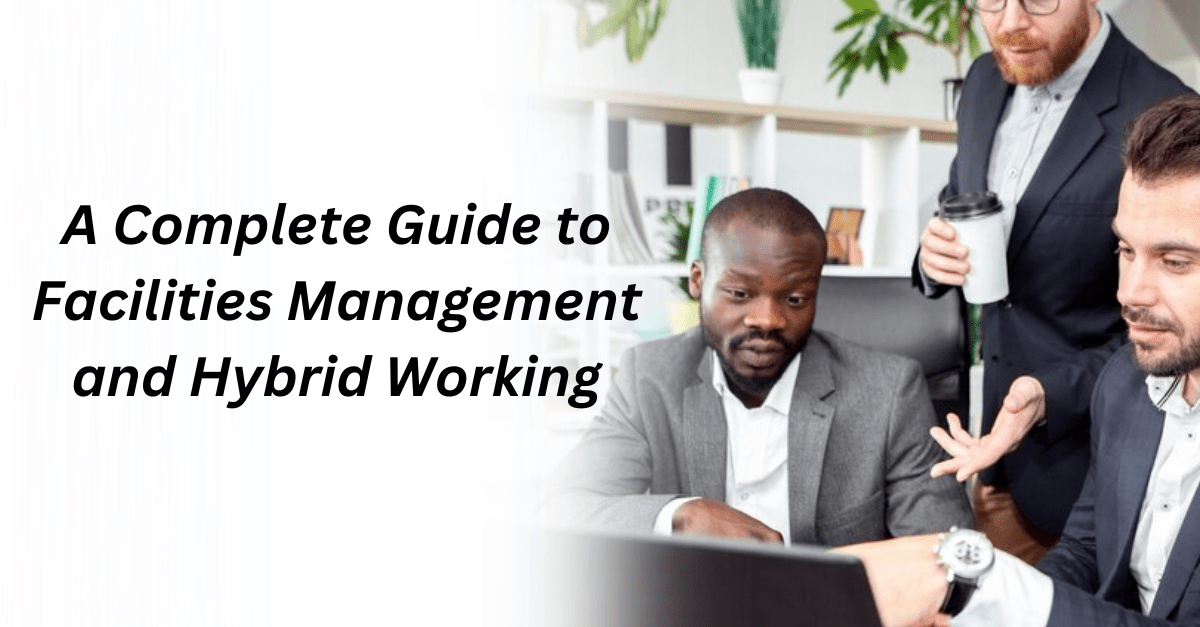Blog

A Complete Guide to office Facilities Management software
Hybrid offices offer many advantages that make them a staple for offices today. One is that companies can save on overhead costs. Next, with employees working from anywhere, companies can also hire from all over the world.
With this in mind, hybrid working also has knock-on effects. More companies adopting hybrid work arrangements have resulted in various changes to office facility management.
In this article, we’ll explore what is office facility management and key questions?. We will discuss and answer why the proper use of the office is still important, what a facility manager is and what they do, how facility departments must be structured, the challenges that come with hybrid working and how facility managers can create an optimized hybrid workspace.
Why is the Physical Office Still Important?
Physical working facilities still matter despite today’s post-pandemic environment. While remote work has its advantages, it can’t replace the benefits that onsite work offers. Here are a few reasons why the office isn’t going away soon:
1. Collaboration
Employees of all levels need to work onsite for various projects. While it’s possible to collaborate online via Zoom or Slack, working in person is best for accomplishing specific tasks.
2. Training
Onboarding new hires or upskilling new employees can be a tricky process. It can be even trickier when done online over Zoom or Skype. Many tasks are best performed and completed in the office.
What is Facility Management?
In a nutshell, facilities management is the daily operations needed to support the work environment an office needs.
Because all organizations need to fulfill at least one key function. This can be serving a community’s needs or generating profits. Facilities management serves as the backbone of organizations in several ways:
1. Productivity
Facility managers need first to ensure that everyone can do their job effectively. It not only means that spaces are clean and organized but also that vehicles and equipment are functioning properly.
On top of that, facility managers are responsible for ensuring a safe, comfortable workplace. Buildings and equipment are subject to inspection to ensure they meet industrial safety standards.
2. Scalability
The process of creating optimal working facilities also affects the organization’s bottom line. This is especially true when the company decides to scale up its operations.
When designing for scalability, facilities managers need to balance available office resources with the number of employees. Additionally, they also need to design the office environment to be cost-effective while still being agile.
3. Sustainability
Facilities managers are responsible for promoting sustainable organizational practices.
Whether it’s waste reduction or energy efficiency, they are responsible for promoting a positive brand image. Through these, facility managers help the company practice corporate social responsibility.
What is a Facility Manager and What Do They Do?
The work environment is constantly changing, and keeping up with the changes to ensure productivity matters more than ever. Facilities managers play a vital role when it comes to working in facilities.
Here are a few questions about facility managers:
1. How Much Does a Facilities Manager Make?
Facilities managers’ average salaries depend on the website, but they can range between $70,000 to $100,000 per year. Your pay depends on how long you’ve held your position.
2. What is the Role of a Facilities Manager?
Facilities managers are generally responsible for a successful workplace. In today’s case, they play a pivotal role in the success of hybrid workplaces. They are responsible for the following:
- Creating a safe and productive work environment for onsite and remote employees
- Assist employers in transitioning to hybrid and flexible work models
- Ensure said smooth transition for both employers and employees
- Emergency and disaster response and mitigation planning
- Space planning and real estate management geared towards sustainability
3. What are the Skills Facility Managers Need?
Office Facility management is a field that requires a surprisingly varied skill set. Managers could be overseeing work on making real estate decisions one day and renovation the next.
Here are a few of the core competencies that facility managers need to master:
Operations and maintenance
Communications
Project management
Sustainability
Risk management
Real estate
Finance and business
How are Facilities Departments Structured?
Like other departments, facility management departments are structured based on the company’s size and internal structure. Smaller companies might only have a one-person team.
However, as organizations grow bigger, more people are needed to take on more roles. For example, organizations can divide their management based on zones, buildings, or locations.
Alternatively, office facility management can also be outsourced to third parties. While outsourcing can be a cost-effective option, there are certain differences:
1. Functions
Core functions are best left to in-house management teams. Meanwhile, peripheral or non-essential functions can be outsourced to third-party teams to distribute the workload.
2. Frequency
Frequency is another difference between in-house and outsourced office facilities management departments. Infrequent functions can be outsourced to third-party management, while in-house often take on more regular functions.
3. Specialty
In-house office facilities management teams specialize in regular office facility management functions. Outsourced services, however, are more likely to be capable of handling more specialized needs.
4. Training Costs
The high training costs of outsourced management teams make them ideal for peripheral, specialized, and infrequent functions. Meanwhile, in-house teams have a lower training cost, but take more time to do so.
What are the Challenges Facility Managers Face in the Hybrid Workplace?
Facility managers often face challenges when transitioning from traditional to hybrid working facilities. However, by addressing them, managers can take better advantage of the benefits agile and flexible workplaces offer.
Here are the challenges you need to consider during the transition to hybrid work:
1. Effective Space Management
Fewer people come to the office as a result of hybrid work. This means reduced ongoing expenses, but it also means a smaller office size.
With this smaller office size comes a potential reduction in work facility capacity. If the number of workstations and office resources is too low, employees might be less productive.
Facility managers need to balance this by monitoring room and desk usage regularly. The good news is workstations, and daily users can be monitored easily with dedicated software that offers real-time data analytics.
2. Utility Management
Utility consumption still matters despite the reduced number of people in the office space. Occupancy rates are a key data point for informed decision-making.
As a result, it’s important to utilize smart solutions that better reflect user occupancy. Managers can include adding motion sensors in various facilities in the office, especially workstations and meeting rooms.
3. Security
As organizations invest in display screens and desk booking tools for meeting rooms, data security becomes a concern.
Facility managers are also responsible for creating a secure environment and accounting for potential security issues. Even though other departments handle data security, they also need to be involved in planning and implementation.
4. Technology
A robust tech stack enables hybrid office models to support flexible and in-office work. Easy-to-use internet and laptop charging docks are just some of the facilities at work needed alongside a dedicated IT team.
Facility managers need to invest in technology that supports both in-office and remote work. These can include the following:
1. Video collaboration tools
2. Collaboration platforms
3. Cloud-based storage solutions (e.g., Google Drive, Dropbox, etc.)
How to Set Up Your Hybrid Workplace to Optimize Office Facility Management
Hybrid offices present new and interesting challenges for facility managers to create an optimal workplace. Here are the ways that facility managers can overcome difficulties in facilities management and hybrid working:
1. Design the Office Layout for Activity-Based Working
Activity-based working allows facility managers to achieve two things. The first is that it lets them make office spaces with a clear purpose. The second is that it gives employees much-needed flexibility to be at their most productive.
Today’s what is a hybrid work schedule facilities are geared towards collaboration. Managers need to focus on creating workspaces that promote collaboration with the help of supporting technology.
On top of that, facility managers should also encourage and facilitate regular communication. Creating opportunities for employees to interact with each other is also crucial, especially for teams in different departments.
Here are a few ways facility managers can do so:
- Designate meeting rooms for brainstorming and collaborative work
- Encourage socialization in common areas, like kitchens or break rooms
- Provide quiet workstations for more focused work
2. Implement Desk Hoteling
In a nutshell, desk hoteling is all about letting employees reserve workspaces ahead of time. This is different from hot-desking, where employees choose desks on a first-come, first-serve basis.
For many offices, desk hoteling is a great way to manage employees with alternating onsite and remote shifts.
Here are a few tips on implementing a fully optimized desk hoteling system with a hybrid software solution:
- Provide an office floor plan: Giving employees an office floor plan improves wayfinding, especially for new hires. Instead of having to remember numbers, visualizing workspaces for reservation is much easier.
- Introduce a reservation tool: Encourage employees to find and book desks via a desktop or mobile app. Users can use the tool to reserve their workstations anytime, anywhere.
- Invite team members to collaborate: Using desk hoteling software, inviting teammates to join each other becomes more convenient.
3. Invest in the Right Tools
Technology serves as the backbone for agile and flexible workplaces. Perhaps one of the most important steps facility managers can take is to invest in the right hybrid software.
In particular, desk hoteling software offers several advantages. Aside from standard workplace reservation, there are numerous features that this kind of software offers, such as:
1. Single sign-on – Never go through the hassle of repeated logins again. Having an active directory allows users within the same network to access shared information in one place.
2. Asset management – Tracking assets and equipment has never been easier. Companies and organizations
3. Facility management – With a reliable resource scheduling system, functions like work order fulfillment, invoicing, and regular maintenance become much easier.
4. Third-party integration – Easy integrations with existing tech stacks make for flexible software with as little required setup as possible.
4. Set Up Work Scheduling
Once you have the tools, it’s time to implement a working schedule for a hybrid schedule.
Efficient work scheduling helps reduce unnecessary spending on utilities. Employees schedule when they work remotely and onsite, allowing facility managers to know when they come in.
Aside from maximizing productivity, work scheduling helps decongest the office and ensures available workspaces for all onsite employees. On top of that, work scheduling can help with the following:
- Base onsite facility work depending on workplace policies and teammate invite frequencies
- Organize work weeks for employees by selecting which locations to work from onsite or remotely
- Stay on top of workplace trends, from the average number of on-site employees to the most popular work areas
5. Choose Data-Driven Decision Making
Data analytics has never been more crucial in today’s ever-changing world.
For facility managers, key decisions depend on access to good data. Having this data can revolutionize how work schedules and office layouts are made to maximize productivity.
The good news is data can be collected in several ways. These can range from the following:
RFID Sensors: Workstations can be equipped with RFID sensors to log employees in automatically. RFID sensors can serve several functions, including tracking the number of reservations per day.
Desk and Meeting Room Reservations: Using hoteling software, managers can track desk reservations employees make.
Equipment Reservations: Hoteling software can also track reservations for equipment and other assets. These can range from computers to copiers.
Motion Sensors: Motion sensors installed in other areas, like break rooms or hallways, to monitor foot traffic.
So, What’s Next for Office Facility Management?
Many organizations and businesses have since returned to in-office work after the pandemic. Today, the workplace is no longer just a workplace, but a place for employees to gather and collaborate.
New workplaces need to be designed to cater to this need, as well as to be as adaptable as possible. With future changes looming, facility managers need the help they can to create a work facility that’s ready for anything.
The Bottom Line
Physical working facilities still matter despite today’s post-pandemic environment. Facilities managers nowadays are tasked with making the physical office flexible to cater to changing needs.
This brings us to the hybrid scheduling workplace, whose many advantages make it ideal for both employees and employers. That said, hybrid working presents new and interesting challenges for facility managers to create the optimal workplace.


















































